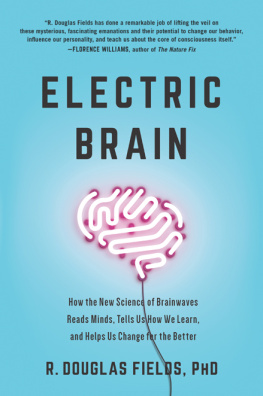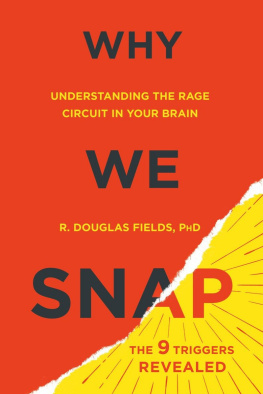Contents
Guide
PRAISE FOR ELECTRIC BRAIN
The Electric Brain tells the story behind one of the most basic and important features of the nervous systemits electrical properties. Forget the hype youve heard about brainwaves. Read Doug Fieldss facile account of the role of brain electrical activity in mind and behavior.
Joseph LeDoux, author of The Deep History of Ourselves: The Four-Billion-Year-Story of How We Got Conscious Brains
Brainwaves, not heartbeat, determine the threshold between life and death. They can control drones and in turn be controlled by machines. Doug Fields has done a remarkable job of lifting the veil on these mysterious, fascinating emanations and their potential to change our behavior, influence our personality, and teach us about the core of consciousness itself.
Florence Williams, author of The Nature Fix
A lively personal account of the wild west of brain wave research, opening multiple windows to deep mysteries underlying our conscious and unconscious selves. Lucid discussions of dreams, mental disorders, mind control, and more provide the reader with a vibrant look into brain science and its impacts on our lives. Strongly recommended.
Paul L. Nunez, PhD, neuroscientist and author of The New Science of Consciousness: Exploring the Complexity of Brain, Mind, and Self
Douglas Fields explains how electricity is exploited in neuronal circuits for both simple and complex functions. He does it in accessible language, embedded in beautiful prose, where beyond discussing fascinating scientific topics of brain works, the scientists come to the fore. A great book to everyone interested in the most complex matter that exists.
Gyrgy Buzski, author of Rhythms of the Brain and The Brain from Inside Out


Electric Brain copyright 2020 by R. Douglas Fields
All rights reserved. No part of this book may be used or reproduced in any manner whatsoever without written permission of the publisher, except in the case of brief quotations embodied in critical articles or reviews.

BenBella Books, Inc.
10440 N. Central Expressway, Suite 800
Dallas, TX 75231
www.benbellabooks.com
Send feedback to
BenBella is a federally registered trademark.
First E-Book Edition: February 2020
Library of Congress Control Number: 2019952185.
ISBN 9781946885456 (trade cloth)
ISBN 9781948836296 (electronic)
Editing by Sheila Curry Oakes and Alexa Stevenson
Copyediting by Elizabeth Degenhard
Proofreading by Sarah Vostok and Cape Cod Compositors, Inc.
Indexing by WordCo Indexing Services, Inc.
Text design by Publishers Design and Production Services, Inc
Cover design by Faceout Studio, Spencer Fuller
Cover image Shutterstock / Sebestyen Balint; image editing by Faceout Studio, Spencer Fuller
Printed by Lake Book Manufacturing
Distributed to the trade by Two Rivers Distribution, an Ingram brand www.tworiversdistribution.com
Special discounts for bulk sales are available.
Please contact .
Dedicated to my father, Richard L. Fields
CONTENTS
B lue panel lights blink ominously on rows of black computers sealed inside a glass room. I walk past the supercomputer nerve center and proceed down an empty, dark corridor. Arriving at a door, I open it and enter a cavernous room painted entirely black. Twenty-four digital cameras stationed around the room pinpoint my every move. Two men stand up from behind a bank of computer screens. I know that by using their sophisticated instruments, they can eavesdrop on electrical transmissions flashing through my brain. The most intimate details of my mind are theirs to see. They can read my thoughts before I have them. They can watch my brain learn. They can glean my intelligence, my propensity for adventurism, identify telltale signatures of mental illness and neurological disorders, and predict my ability to learn specific types of material. Am I a good reader? Bad at arithmetic? Prone to depression? Developing early stages of Parkinsons disease? These deeply personal insights into my mind are available to them and other brain scientists who are propelling a revolutionary leap in neuroscience that will transform our world.
Ive come to this place to meet these two neuroscientists and experience for myself how they can watch my brain learn by tracking my brainwaves. There is no need to open my skull and stick electrodes into my brain to tap into my neural circuits. Electricity zipping through thousands of neurons deep inside my cerebral cortex creates electromagnetic waves of energy that penetrate my scalp. These electrical discharges can be picked up by touching a wire to my head and feeding the electrical signals from my brain through the wire into a computer. In Electric Brain I will take you to this and many other laboratories around the world to see this exciting new brain science currently unfolding, and to trace back in time to find the roots of this discovery.
The detection of brainwaves in the early twentieth century is one of the most important developments in the history of neuroscience, yet brainwaves and their momentous implications are poorly understood by the general public. Brainwaves arent taught in school. In fact, most college neuroscience textbooks lack a chapter on brainwaves. This situation has persisted for nearly a century. Yet, learning about brainwaves isnt complicatedanyone who is truly interested can easily understand this new science.
But brainwaves have always been surrounded in controversy. From the moment a reclusive German doctor in the 1920s discovered waves of electricity radiating out of the heads of his patients in a mental hospital, brainwaves sparked astonishment and deep intrigue. His secret experiments revealed that these cryptic electromagnetic emanations from the innermost workings of our mind change with our thoughts and mental state. Today we know that these bioelectric broadcasts expose the most intimate privacies: our conscious thoughts, our unconscious cognition, and the emotions stirring inside our brain.
From the moment scientists first glimpsed brainwaves at the turn of the twentieth century, they were seen as complex and mysterious emanations. The controversy continues, as brainwaves are hotly debated by neuroscientists today. Some dismiss brainwaves as the electrical noise of the brain at work, like the roar of an automobile engine is a by-product of its mechanism of operation. Others believe brainwaves are how the brain functions at its most sophisticated level. Brainwaves, these scientists believe, explain many complex aspects of the human mind that have long mystified philosophers and scientists alike.
While scientific debate rages over the origin and function of brainwaves, no one questions the extraordinary capabilities that can be achieved by monitoring and altering them. Neuroscientists can feed brainwaves into computers to control software, machines, and prosthetic limbs. This melding through brainwaves can fuse man and machine into unparalleled levels of perception, analysis, and problem-solving that far exceed the capability of a digital computer or the human brain working alone. Conscious and even preconscious thoughts can control everything from a motorized wheelchair to a fighter drone. Consciousness and brainwaves are so tightly interwoven that brainwaves, not the heartbeat, now define the threshold between life and death. Psychologists analyzing the pattern of brainwaves in a persons brain as they sit quietly letting their mind wander can see how that individuals brain is wirednormally or abnormally. If the brains electromagnetic oscillations are atypical, the practitioner can program a computer to signal the patient when their brains electrical activity shifts in the appropriate way, and given this feedback, the brain will correct its brainwave activityhealing itself without drugs.
Next page









